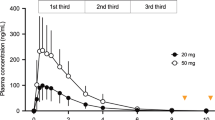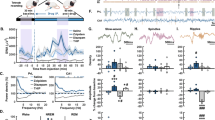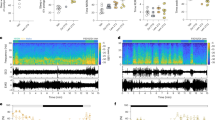Abstract
Orexins have a role in sleep regulation, and orexin receptor antagonists are under development for the treatment of insomnia. We conducted a randomised, double-blind, placebo-controlled, four-period crossover study to investigate the effect of single doses of the dual orexin receptor antagonist SB-649868 (10 or 30 mg) and a positive control zolpidem (10 mg), an allosteric modulator of GABAA receptors. Objective and subjective sleep parameters and next-day performance were assessed in 51 healthy male volunteers in a traffic noise model of situational insomnia. Compared with placebo, SB-649868 10 and 30 mg increased total sleep time (TST) by 17 and 31 min (p<0.001), whereas after zolpidem TST was increased by 11.0 min (p=0.012). Wake after sleep onset was reduced significantly by 14.7 min for the SB–6489698 30 mg dose (p<0.001). Latency to persistent sleep was significantly reduced after both doses of SB–6489698 (p=0.003), but not after zolpidem. Slow wave sleep (SWS) and electroencephalogram (EEG) power spectra in non-REM sleep were not affected by either dose of SB-640868, whereas SWS (p< 0.001) and low delta activity (<=1.0 Hz) were increased, and 2.25–11.0 Hz activity decreased after zolpidem. REM sleep duration was increased after SB-649868 30 mg (p=0.002) and reduced after zolpidem (p=0.049). Latency to REM sleep was reduced by 20.1 (p=0.034) and 34.0 min (p<0.001) after 10 and 30 mg of SB-649868. Sleep-onset REM episodes were observed. SB-649868 was well tolerated. This dual orexin receptor antagonist exerts hypnotic activity, with effects on sleep structure and the EEG that are different from those of zolpidem.
Similar content being viewed by others
Log in or create a free account to read this content
Gain free access to this article, as well as selected content from this journal and more on nature.com
or
References
Beersma DG, Daan S, Van den Hoofdakker RH (1984). Distribution of REM latencies and other sleep phenomena in depression as explained by a single ultradian rhythm disturbance. Sleep 7: 126–136.
Bettica P, Nucci G, Pyke C, Squassante L, Zamuner S, Ratti E et al (2011). Phase I studies on the safety, tolerability, pharmacokinetics and pharmacodynamics of SB-649868, a novel dual orexin receptor antagonist. J Psychopharmacol; e-pub ahead of print 5 July 2011.
Boyle J, Wolford D, Gargano C, McCrea J, Cummings C, Cerchio K et al (2009). Next-day residual effects of gaboxadol and flurazepam administered at bedtime: a randomized double-blind study in healthy elderly subjects. Hum Psychopharmacol 24: 61–71.
Brisbare-Roch C, Dingemanse J, Koberstein R, Hoever P, Aissaoui H, Flores S et al (2007). Promotion of sleep by targeting the orexin system in rats, dogs and humans. Nat Med 13: 150–155.
Brown RE, Sergeeva O, Eriksson KS, Haas HL (2001). Orexin A excites serotonergic neurons in the dorsal raphe nucleus of the rat. Neuropharmacology 40: 457–459.
Brunner DP, Dijk DJ, Munch M, Borbely AA (1991). Effect of zolpidem on sleep and sleep EEG spectra in healthy young men. Psychopharmacology (Berl) 104: 1–5.
Chemelli RM, Willie JT, Sinton CM, Elmquist JK, Scammell T, Lee C et al (1999). Narcolepsy in orexin knockout mice: molecular genetics of sleep regulation. Cell 98: 437–451.
Chen W, Zeitzer JM, Mignot E . The hypocretins and narcolepsy. In: Lecea L, Sutcliffe JG (eds). Hypocretins: Integrators of Physiological Functions. Springer: New York; 2005, pp 233–252.
Cluydts R, De Roeck J, Cosyns P, Lacante P (1995). Antagonizing the effects of experimentally induced sleep disturbance in healthy volunteers by lormetazepam and zolpidem. J Clin Psychopharmacol 15: 132–137.
Crochet S, Onoe H, Sakai K (2006). A potent non-monoaminergic paradoxical sleep inhibitory system: a reverse microdialysis and single-unit recording study. Eur J Neurosci 24: 1404–1412.
Deboer T, Overeem S, Visser NA, Duindam H, Frolich M, Lammers GJ et al (2004). Convergence of circadian and sleep regulatory mechanisms on hypocretin-1. Neuroscience 129: 727–732.
Dijk DJ, Czeisler CA (1995). Contribution of the circadian pacemaker and the sleep homeostat to sleep propensity, sleep structure, electroencephalographic slow waves, and sleep spindle activity in humans. J Neurosci 15: 3526–3538.
Dijk DJ, James LM, Peters S, Walsh JK, Deacon S (2010). Sex differences and the effect of gaboxadol and zolpidem on EEG power spectra in NREM and REM sleep. J Psychopharmacol 24: 1613–1618.
Dijk DJ, Stanley N, Groeger JA, Legters A, Deacon S (2007). Gaboxadol reduces the detrimental effects of traffic noise on sleep: A randomised, double-blind, placebo-controlled, parallel group study in healthy subjects. Sleep 30: A253.
Dijk DJ, Stanley N, Lundahl J, Groeger JA, Legters A, Trap Huusom AK et al (2011). Enhanced slow wave sleep and improved sleep maintenance after gaboxadol administration during seven nights of exposure to a traffic noise model of transient insomnia. J Psychopharmacol; e-pub ahead of print 13 October 2011.
Eriksson KS, Sergeeva O, Brown RE, Haas HL (2001). Orexin/hypocretin excites the histaminergic neurons of the tuberomammillary nucleus. J Neurosci 21: 9273–9279.
Eriksson KS, Sergeeva OA, Haas HL, Selbach O (2010). Orexins/hypocretins and aminergic systems. Acta Physiol (Oxf) 198: 263–275.
Eriksson KS, Sergeeva OA, Selbach O, Haas HL (2004). Orexin (hypocretin)/dynorphin neurons control GABAergic inputs to tuberomammillary neurons. Eur J Neurosci 19: 1278–1284.
Fort P, Bassetti CL, Luppi PH (2009). Alternating vigilance states: new insights regarding neuronal networks and mechanisms. Eur J Neurosci 29: 1741–1753.
Gerrard PA, Porter RA, Holland V, Massagrande M, Poffe A, Piccoli L et al (2009). Preclinical pharmacology of SB-649868: a novel orexin OX1/OX2 receptor antagonist possessing potent hypnotic activity in rodents and primates. Sleep 32: A42.
Hagan JJ, Leslie RA, Patel S, Evans ML, Wattam TA, Holmes S et al (1999). Orexin A activates locus coeruleus cell firing and increases arousal in the rat. Proc Natl Acad Sci USA 96: 10911–10916.
Hindmarch I, Patat A, Stanley N, Paty I, Rigney U (2001). Residual effects of zaleplon and zolpidem following middle of the night administration five hours to one hour before awakening. Hum Psychopharmacol 16: 159–167.
Kanno O, Sasaki T, Watanabe H, Takazawa S, Nakagome K, Nakajima T et al (2000). Comparison of the effects of zolpidem and triazolam on nocturnal sleep and sleep latency in the morning: a cross-over study in healthy young volunteers. Prog Neuropsychopharmacol Biol Psychiatry 24: 897–910.
Lancel M (1999). Role of GABAA receptors in the regulation of sleep: initial sleep responses to peripherally administered modulators and agonists. Sleep 22: 33–42.
Lee MG, Hassani OK, Jones BE (2005). Discharge of identified orexin/hypocretin neurons across the sleep-waking cycle. J Neurosci 25: 6716–6720.
Lim J, Dinges DF (2008). Sleep deprivation and vigilant attention. Ann NY Acad Sci 1129: 305–322.
Luppi PH, Clement O, Sapin E, Gervasoni D, Peyron C, Leger L et al (2011). The neuronal network responsible for paradoxical sleep and its dysfunctions causing narcolepsy and rapid eye movement (REM) behavior disorder. Sleep Med Rev 15: 153–163.
Mieda M, Hasegawa E, Kisanuki YY, Sinton CM, Yanagisawa M, Sakurai T (2011). Differential roles of orexin receptor-1 and -2 in the regulation of non-REM and REM sleep. J Neurosci 31: 6518–6526.
Mignot E (2004). Sleep, sleep disorders and hypocretin (orexin). Sleep Med 5 (Suppl 1): S2–S8.
Mohler H (2006). GABA(A) receptor diversity and pharmacology. Cell Tissue Res 326: 505–516.
niz Behn CG, Klerman EB, Mochizuki T, Lin SC, Scammell TE (2010). Abnormal sleep/wake dynamics in orexin knockout mice. Sleep 33: 297–306.
Nutt DJ, Stahl SM (2010). Searching for perfect sleep: the continuing evolution of GABAA receptor modulators as hypnotics. J Psychopharmacol 24: 1601–1612.
Piper DC, Upton N, Smith MI, Hunter AJ (2000). The novel brain neuropeptide, orexin-A, modulates the sleep-wake cycle of rats. Eur J Neurosci 12: 726–730.
Rechtschaffen A, Kales A . A Manual of Standardized Terminology, Techniques and Scoring System for Sleep Stages of Human Subjects. US Government Printing Office: Washington, DC; 1968.
Roth T, Coulouvrat C, Hajak G, Lakoma MD, Sampson NA, Shahly V et al (2011). Prevalence and perceived health associated with insomnia based on DSM-IV-TR; International Statistical Classification of Diseases and Related Health Problems, Tenth Revision; and Research Diagnostic Criteria/International Classification of Sleep Disorders, Second Edition criteria: results from the America Insomnia Survey. Biol Psychiatry 69: 592–600.
Sakurai T, Mieda M (2011). Connectomics of orexin-producing neurons: interface of systems of emotion, energy homeostasis and arousal. Trends Pharmacol Sci 32: 451–462.
Saper CB, Fuller PM, Pedersen NP, Lu J, Scammell TE (2010). Sleep state switching. Neuron 68: 1023–1042.
Sarsour K, Kalsekar A, Swindle R, Foley K, Walsh JK (2011). The Association between Insomnia Severity and Healthcare and Productivity Costs in a Health Plan Sample. Sleep 34: 443–450.
Scammell TE, Winrow CJ (2011). Orexin receptors: pharmacology and therapeutic opportunities. Annu Rev Pharmacol Toxicol 51: 243–266.
Stone BM, Turner C, Mills SL, Paty I, Patat A, Darwish M et al (2002). Noise-induced sleep maintenance insomnia: hypnotic and residual effects of zaleplon. Br J Clin Pharmacol 53: 196–202.
Sullivan SS, Guilleminault C (2009). Emerging drugs for insomnia: new frontiers for old and novel targets. Expert Opin Emerg Drugs 14: 411–422.
Winsky-Sommerer R (2009). Role of GABAA receptors in the physiology and pharmacology of sleep. Eur J Neurosci 29: 1779–1794.
Xi MC, Morales FR, Chase MH (2001). Effects on sleep and wakefulness of the injection of hypocretin-1 (orexin-A) into the laterodorsal tegmental nucleus of the cat. Brain Res 901: 259–264.
Yoshida K, McCormack S, Espana RA, Crocker A, Scammell TE (2006). Afferents to the orexin neurons of the rat brain. J Comp Neurol 494: 845–861.
Zeitzer JM, Buckmaster CL, Parker KJ, Hauck CM, Lyons DM, Mignot E (2003). Circadian and homeostatic regulation of hypocretin in a primate model: implications for the consolidation of wakefulness. J Neurosci 23: 3555–3560.
Acknowledgements
We thank the staff of the Surrey Clinical Research Centre at the University of Surrey for the conduct of the study, Dr Sigurd Johnsen for summary statistics for the EEG power spectra, and Giuseppe Atzori with help in preparing some of the figures. Supportive editorial services were contributed by Gary Evoniuk, PhD, GlaxoSmithKline. This study was registered on ClinicalTrials.gov with the following identifier: NCT00440323. This study was sponsored by GlaxoSmithKline.
Author information
Authors and Affiliations
Corresponding author
Ethics declarations
Competing interests
Paolo Bettica and Lisa Squassante were full-time employees at GlaxoSmithKline at the time of the design conduct and reporting of this study. Dr Winsky-Sommerer has no conflict of interest. Dr Groeger has contributed to research projects funded by Road Safety Authority (Irl), Science Foundation, Ireland, US Air Force Office of Scientific Research, Eisai, Glaxo Smith Kline (GSK), Eli Lilly, and has been compensated directly, or through the University of Surrey, for his engagement by the latter four sponsors. Dr Gennery was an employee of the University of Surrey to which GSK provided funds to conduct this study. Dr Dijk has contributed to research projects funded by GSK, Eli Lilly, Merck, Ono Pharma, Philips, Airforce Office of Scientific Research, Biotechnology and the Biological Sciences Research Council. He has provided consulting services to Johnson and Johnson, Sanofi-Aventis, Metro Naps, Pepsi Co, Actelion, Cephalon, GSK, Eli Lilly, Merck, Ono Pharma, UCB, and CHDI.
Rights and permissions
About this article
Cite this article
Bettica, P., Squassante, L., Groeger, J. et al. Differential Effects of a Dual Orexin Receptor Antagonist (SB-649868) and Zolpidem on Sleep Initiation and Consolidation, SWS, REM Sleep, and EEG Power Spectra in a Model of Situational Insomnia. Neuropsychopharmacol 37, 1224–1233 (2012). https://doi.org/10.1038/npp.2011.310
Received:
Revised:
Accepted:
Published:
Issue date:
DOI: https://doi.org/10.1038/npp.2011.310
Keywords
This article is cited by
-
An examination of sleep spindle metrics in the Sleep Heart Health Study: superiority of automated spindle detection over total sigma power in assessing age-related spindle decline
BMC Neurology (2023)
-
Doxepin is more effective than zolpidem in improving executive function in patients with insomnia disorder
Sleep and Breathing (2023)
-
Effects of the selective orexin-2 receptor antagonist JNJ-48816274 on sleep initiated in the circadian wake maintenance zone: a randomised trial
Neuropsychopharmacology (2022)
-
Dual Orexin Receptor Antagonists (DORAs) as an Adjunct Treatment for Smoking Cessation
CNS Drugs (2022)
-
Nonclinical pharmacology of daridorexant: a new dual orexin receptor antagonist for the treatment of insomnia
Psychopharmacology (2021)



